
8 Hour Session: DSOs, Asteroids, Planets,
Comet, Spectroscopy, Moon
Posted: 20 October 2011
The observatory was opened Wednesday, 19 October, at 1811 MST, 83°F. First, took a quick look at Venus, low and in tree branches, with 26mm eyepiece. Then at 1830 MST, viewed M13 (globular cluster), visible in a still-bright sky with 26mm eyepiece. At 1841 MST, I happened to look up towards the zenith and saw a bright polar orbiting satellite moving south past Altair. It faded out just south of Aquila. I'm not sure what satellite it was; Heavens-Above didn't show anything that bright (about the same magnitude as Altair) at that time.
I switched to the 2" 30mm eyepiece (67X) and viewed M13. At 1855 MST, viewed M101 (galaxy), low in the twilight sky. I could faintly see some spiral arms. Then viewed M81 and M82 (galaxies), very low in the north. Both were in the same FOV with the 2" 30mm eyepiece. Next, I spent some time observing M11 (Wild Duck Cluster) trying to see the "duck" pattern in the stars. I viewed from many different positions around the eyepiece but never saw the duck. I did see a "M" and "W" pattern (appropriate), as well as a pattern that looked like a cat with a bushy tail standing up on all four legs. Maybe I'll call M11 the "Kitty Cat Cluster".
At 1915 MST, viewed the asteroid Vesta and then the asteroid Ceres. Next, viewed Neptune. Even at this low magnification, Neptune's small disk was visible. Then viewed Uranus; its larger disk was easily visible. Then viewed Jupiter, very low in the eastern sky; four moons were visible. At 1938 MST, viewed Comet C/2009 P1 (Garradd) in the 2" 30mm eyepiece. The nucleus, coma, and faint tail were visible. At 1948 MST, using the 8x50 finderscope on the telescope as a guide, viewed the comet with 7x50 binoculars as a small fuzzy spot in the sky. Then I switched to the 1.25" 9.7mm (206X), then 1.25" 5.5mm (364X), then 15mm (133X) eyepieces and viewed the comet. The nucleus and coma were visible; the best view was at 133X.
Switched back to the 2" 30mm eyepiece and at 2008 MST, viewed the Double Cluster. Both clusters were in the same FOV. Switched to the 2" 50mm (40X) eyepiece; that was a great view with lots of stars visible. At 2014 MST, checked on Jupiter; still four moons visible. The planet was very bright at this low magnification (40X).
Beginning at 2039 MST, I began some observations of the variable star Mira, currently in its brightest phase. I estimated the current magnitude at +3. At 2100 MST, I returned to Jupiter; one moon was about to disappear behind the planet. I checked the "Pocket Universe" app on my iPhone and learned that the moon was Io. At 2104 MST, viewed M45 (Pleiades) with the 2" 50mm eyepiece. Great view. All the "seven sisters" stars were in the same FOV and there was some nebulosity visible. Playing on my iPod in the background inside the observatory was the Hearts of Space album "Music from the Pleiades". Very appropriate.
At 2140 MST, returned once again to Jupiter, this time using the 1.25" eyepieces. Io was now gone, with only three moons visible. I used the 9.7mm eyepiece + moon filter to observe the planet. Nice view. At 2150 MST, I set up for iPhone 4 imaging of Jupiter using the "MX-1 Afocal Adapter". This image was taken with a 9mm + 3X TeleXtender (yielding 666X):
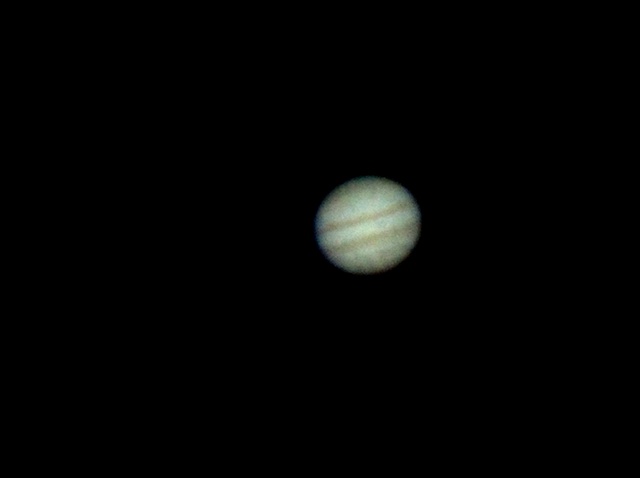
At 2218 MST, I switched from the iPhone to the D7000 DSLR. This is a cropped image, 1/200sec, ISO 800, taken at prime focus:
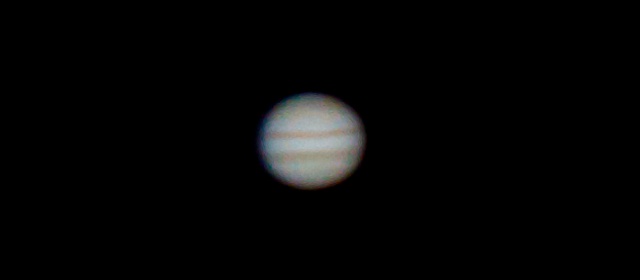
This is a cropped image, 1/200sec, ISO 800, taken at prime focus + 3X TeleXtender:
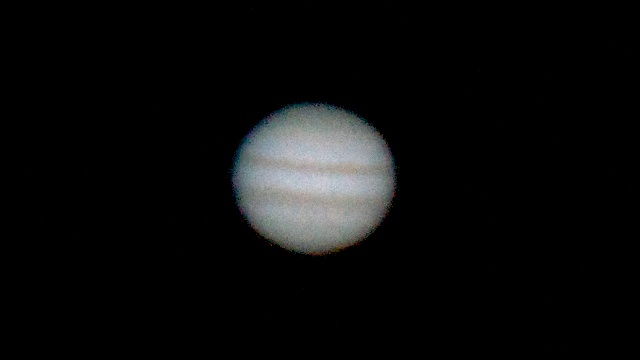
At 2237 MST, I began setting up for Mira spectroscopy imaging using the D7000 DSLR and Star Analyser. This is a processed 1/10sec, ISO 2000, spectrum:
The Fraunhofer lines were easily seen in the image on the camera's viewscreen. I removed the camera and attached the Star Analyser to the 15mm eyepiece. Wow, the lines were clearly visible to the eye. I then attached the Star Analyser to a 9mm eyepiece and took this Mira spectrum with the iPhone (unprocessed):
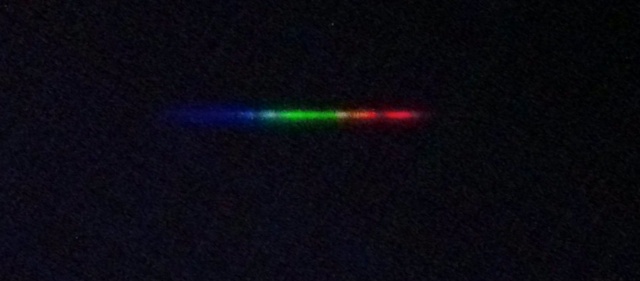
Here is the processed version of the iPhone spectrum of Mira:
Amazing that the iPhone can do spectroscopy!
At 2312 MST, I ended imaging and viewed M1 (Crab Nebula) in the 26mm eyepiece. It was a good view, with some structure visible. I tried using the OIII and Hydrogen Beta filters but neither improved the view. In fact, they hampered it by reducing the brightness of M1. Switched to the 2" 30mm eyepiece (no filters); M1 was a little brighter than it had been with the 1.25" 26mm eyepiece. The shape was obvious. At 2348 MST, the eastern sky was beginning to brighten from the rising near Last Quarter moon.
At 0000 MST, slewed to Betelgeuse and began setting for some more D7000 spectroscopy. This is a processed 1/30sec, ISO 1000, image:
And Rigel, 1/25sec, ISO 1000:
I ended imaging at 0025 MST and viewed M42 (Great Nebula in Orion) with 2" 50mm eyepiece (40X). There was a lot of structure visible. But the best view was with the 2" 30mm (67X) eyepiece; M42 filled the entire FOV, with a lot of very faint structure visible. And the Trapezium was lovely. Even with the sky brightening from the moon, the view was excellent.
At 0043 MST, went to the moon, still low in the eastern sky. At 0054 MST, I began viewing the terminator with the 1.25" 5.5mm and 9.7mm eyepieces. There were some impressive views. The crater Copernicus was especially nice at 364X. I switched to the visual back (from the diagonal) and took this 1/320sec, ISO 500, exposure with the D7000 at prime focus:
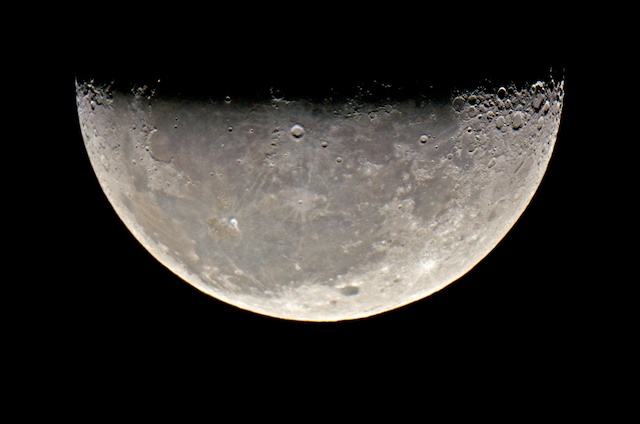
This image of Copernicus is a cropped, 1/400sec, ISO 2000, exposure at prime focus + 3X TeleXtender:
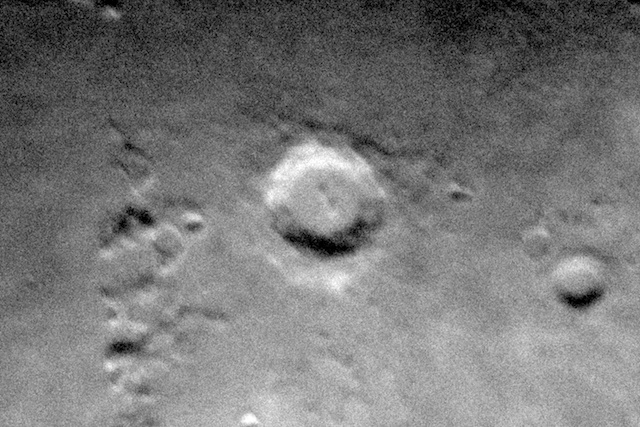
Compare the D7000 image of Copernicus above to this iPhone 4 afocal, 9mm + 3X TeleXtender, slightly cropped image:
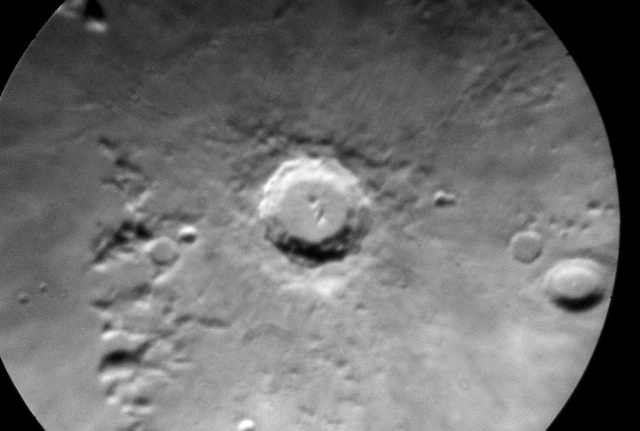
And this is a slightly cropped frame from an iPhone 4 video recording, 9mm + 3X TeleXtender:
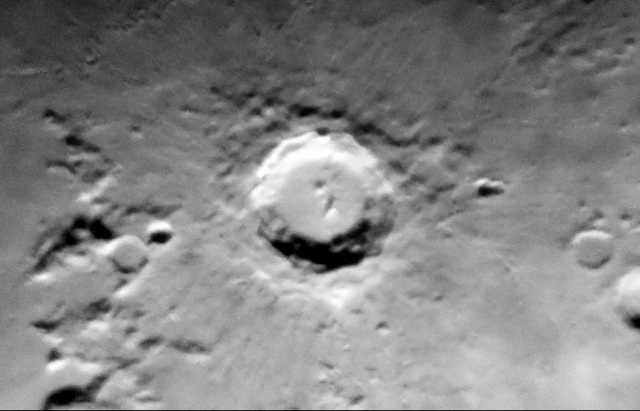
The iPhone can do some amazing lunar astrophotography.
At 0155 MST, I ended imaging for the night and viewed Copernicus at 400X, 619X, and 1091X. The views were nice at all magnifications, with a lot of details on the crater wall and floor. I began closing up. But then I noticed that Mars had risen over the hill, so I took a quick look at it at 77X. A small disk was visible, but there were no details seen (due to the low altitude). But seeing Mars made for five planets this night.
Closed the observatory at 0215 MST, 67°F, after an excellent 8-hour session.
Go to the previous report.
Return to the Cassiopeia Observatory Welcome Page.